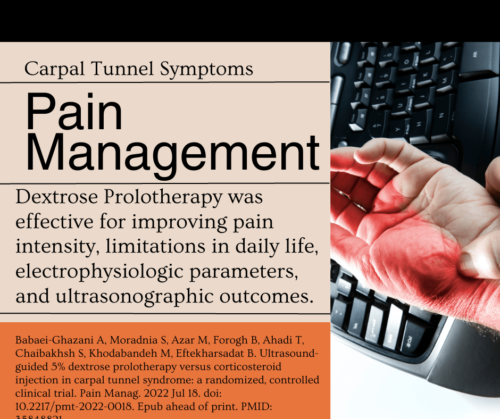Do you think you may have Carpal Tunnel Syndrome? Actual carpal tunnel syndromes are caused by median nerve compression. Symptoms of carpal tunnel can also be related to ligament injury. Both conditions can present with the same or similar symptoms but have different pathology. Joint instability may be the source of the problem in either case. Regenerative Orthopedics is a carpal tunnel syndrome treatment that stabilizes the joint and can effectively treat the problem.
A physician who understands the referral patterns of ligaments should be sought to ascertain if the ligaments are the source of the problem. Regenerative Orthopedics works well to treat the pain, numbness, and tingling associated with carpal tunnel syndrome or when the symptoms of carpal tunnel syndrome are caused by ligament damage.
Surgery is a standard go-to when it comes to Carpal Tunnel Syndrome. But is surgery inevitable? Although the standard practice of modern medicine is to inject steroids or to prescribe anti-inflammatory medications, the result of a diagnosis of carpal tunnel syndrome is usually surgery. Is surgery the answer?

Carpal Tunnel surgery has limited and widely varying degrees of success in treating carpal tunnel syndrome. Muscle & Nerve: Official Journal of the American Association of Electrodiagnostic Medicine says, “years after its widespread recognition, a significant minority of patients with carpal tunnel syndrome continue to experience poor outcomes from treatment.” (1) With over 600,000 carpal tunnel release surgeries performed annually in the U.S., that would account for many failures.
Some failures are due to misdiagnosis, where the median nerve is not causing the symptoms. In our office, we have seen patients with carpal tunnel-like symptoms who have symptoms caused by a ligament injury. To ascertain the source, a complete history and evaluation must be completed.
Ligament laxity may be the source of the symptoms. A complete history and evaluation are needed before diagnosing carpal tunnel syndrome. Electrodiagnostic studies and imaging may be necessary. Additionally, a physician who understands the referral patterns of ligaments should evaluate the individual with this condition before surgery is considered. Because most physicians do not know the referral pain patterns of ligaments, they do not realize that the cervical vertebrae 4 and 5 and the annular ligament can refer pain to the thumb, index, and middle fingers. Ligament laxity can also cause numbness. Cervical and annular ligament laxity should always be evaluated before diagnosing carpal tunnel syndrome.
Regenerative Orthopedics repairs injured and weakened ligaments. If ligaments are the source of the problem, then these treatments, which specifically address injured ligaments, can be sought.
Ligament injury can often cause a variety of symptoms. When carpal tunnel surgery is performed, ligaments are cut. Why chance additional injury if cutting is not necessary? A 2023 article in the Journal of Biomechanical Engineering says, “Carpal tunnel release surgery transects the transverse carpal ligament to expand the tunnel arch space, decompress the median nerve, and relieve the associated symptoms. However, the surgical procedure unavoidably disrupts essential anatomical, biomechanical, and physiological functions of the wrist, potentially causing reduced grip strength, pillar pain, carpal bone instability, scar tissue formation, and perineural fibrosis.” (2) Looking into non-surgical alternatives may be the answer to avoid this problem.
Actual carpal tunnel syndromes are caused by median nerve compression, and pseudo carpal tunnel syndromes are caused by ligament weakness. Joint instability can be at the core of both problems, as looseness and abnormal movement in the joint can cause compression on the nerve. Regenerative treatment of joint instability can be effective in treating these conditions. They both may present with the same or similar symptoms but have some different pathology.
Regenerative Orthopedic injections to the injured areas result in the stabilization of the joint, strengthening, and repair of these soft tissue structures. The ligaments become tighter and stronger, eliminating the causative factor.
The medical journal Pain Management concluded that Dextrose Prolotherapy was effective for improving pain intensity, limitations in daily life, electrophysiologic parameters, and ultrasonographic outcomes. (3)
The journal Pharmaceuticals concluded, “D5W and PRP injections are more effective than splinting and corticosteroid or saline injection for relieving the symptoms of CTS.” (4)
Additionally, university researchers in Taiwan found that “Platelet Rich Plasma (PRP) is a safe modality that relieves pain and improves disability in patients with carpal tunnel syndrome.” (5)
Regenerative Orthopedics works well to treat the pain, numbness, and tingling associated with carpal tunnel syndrome and when the symptoms of carpal tunnel syndrome are caused by ligament damage. If symptoms of carpal tunnel syndrome are found to be due to weak ligaments, then Regenerative Orthopedics would be recommended to strengthen the affected wrist ligaments.
If a person has significant tenderness over the lateral elbow (radius) and no evidence of muscle atrophy (weakness) or sensory deficit in the hand, they likely have ‘pseudo’ carpal tunnel syndrome. The annular ligament, which enables the hand to rotate, becomes lax through use in repetitive tasks or athletics, leading to chronic pain in the elbow and/or referred pain in the wrist. These ligaments have referral pain patterns that travel down to the wrist and fingers and may be confused with carpal tunnel syndrome. When examining a patient with these symptoms, it is essential to examine the elbow as well.
Prolotherapy treatments to the lateral collateral ligament (i.e., the radial collateral ligament) and annular ligament of the elbow will help to strengthen these tissues and stop the pain referral patterns down the arm and into the fingers. This problem commonly occurs in people who type frequently or use their arms and elbows at work, such as workers, carpenters, or hairdressers. While operations for carpal tunnel syndrome are sometimes needed, Regenerative Orthopedics can help eliminate the need for surgery and cure a patient’s chronic pain.